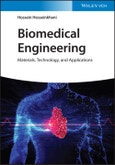Biomedical Engineering
An exploration of materials processing and engineering technology across a wide range of medical applications
The field of biomedical engineering has played a vital role in the progression of medical development technology. Biomedical Engineering: Materials, Technology, and Applications covers key aspects of the field - from basic concepts to advanced level research for medical applications. The book stands as a source of inspiration for research on materials as well as their development and practical application within specialized industries. It begins with a discussion of what biomedical engineering is and concludes with a final chapter on the advancements of biomaterials technology in medicine. - Offers comprehensive coverage of topics, including biomaterials, tissue engineering, bioreceptor interactions, and various medical applications - Discusses applications in critical industries such as biomedical diagnosis, pharmaceutics, drug delivery, cancer detection, and more - Serves as a reference for those in scientific, medical, and academic fields
Biomedical Engineering takes an interdisciplinary look at how biomedical science and engineering technology are integral to developing novel approaches to major problems, such as those associated with disease diagnosis and drug delivery. By covering a full range of materials processing and technology-related subjects, it shares timely information for biotechnologists, material scientists, biophysicists, chemists, bioengineers, nanotechnologists, and medical researchers.
An exploration of materials processing and engineering technology across a wide range of medical applications
The field of biomedical engineering has played a vital role in the progression of medical development technology. Biomedical Engineering: Materials, Technology, and Applications covers key aspects of the field - from basic concepts to advanced level research for medical applications. The book stands as a source of inspiration for research on materials as well as their development and practical application within specialized industries. It begins with a discussion of what biomedical engineering is and concludes with a final chapter on the advancements of biomaterials technology in medicine. - Offers comprehensive coverage of topics, including biomaterials, tissue engineering, bioreceptor interactions, and various medical applications - Discusses applications in critical industries such as biomedical diagnosis, pharmaceutics, drug delivery, cancer detection, and more - Serves as a reference for those in scientific, medical, and academic fields
Biomedical Engineering takes an interdisciplinary look at how biomedical science and engineering technology are integral to developing novel approaches to major problems, such as those associated with disease diagnosis and drug delivery. By covering a full range of materials processing and technology-related subjects, it shares timely information for biotechnologists, material scientists, biophysicists, chemists, bioengineers, nanotechnologists, and medical researchers.
Table of Contents
1. CONCEPTS of BIOMEDICAL ENGINEERING1.1 Introduction
1.2 What is Biomedical Engineering
1.3 Frontiers in Biomedical Engineering
1.4 Impact of Biomedical Engineering
1.4.1 Target Drug Delivery
1.4.2 Early Stage Detection
1.4.3 Personalized Medicine
1.5 General Applications of Biomedical Engineering
1.5.1 Pharmaceutic
1.5.2 Medicine
1.5.3 Consumer Goods
1.6 Summary and Challenges
References
2. BIOMATERIALS
2.1 Introduction
2.2 Biomedical Materials
2.2.1 Polymers
2.2.2 Metals
2.2.3 Composites
2.2.4 Non-Metal Materials
2.3 Biomaterials in Medicine
2.3.1 Surgical Devices
2.3.2 Implantable and Injectable Materials
2.4 Summary and Challenges
References
3 BIOMOLECULE RESPONSIVE MATERIALS
3.1 Introduction
3.2 Glucose Responsive Materials
3.2.1 Glucose Oxidase Materials
3.2.2 Phenylboronic Acid Materials
3.3 Protein Responsive Materials
3.3.1 Enzyme-Responsive Materials
3.3.2 Antigen-Responsive Materials
3.4 Nucleic Acid Responsive Materials
3.4.1 RNA-Responsive Materials
3.4.2 DNA-Responsive Materials
3.4.3 Aptamers-Responsive Materials
3.4.4 PNA-Responsive Materials
3.5 Summary and Challenges
References
4. SURFACE CHEMISTRY of BIOMATERIALS for MEDICAL APPLICATION
4.1 Introduction
4.2 Chemical Method
4.2.1 Radiation Grafting
4.2.2 Silanization
4.3 Electrochemical Method
4.3.1. Conversion Coatings
4.3.2. Electroplating
4.4. Plasma Method
4.4.1 High-Energy Plasma Treatments
4.4.2 Immobilization of Molecules
4.5 Ion Beam Implantation
4.6 Summary and Challenges
References
5 DRUG DELIVERY TECHNOLOGY
5.1 Introduction
5.2 Biodegradable Polymers in Drug Delivery
5.2.1 Gene Delivery
5.2.2 siRNA Delivery
5.3 Target Drug Delivery
5.3.1 Target Therapy in Cancer
5.3.2 Target Therapy in Diabetes
5.4 Drug Delivery in Imaging Technology
5.4.1 MRI Technology
5.4.2 Ultrasound Technology
5.5 Summary and Challenges
References
6 EARLY STAGE DETECTION TECHNOLOGY
6.1 Introduction
6.2 Sensors Biological Application
6.3 Fabrication Methods
6.3.1 Lithography Technology
6.3.2 Printing Technology
6.4 Current Approaches
6.4.1 Lab-on-Chip
6.4.2 Organ-on-Chip
6.4.3 Drug Screening
6.5 Summary and Challenges
References
7 REGENERATIVE MEDICINE
7.1 Introduction
7.2 The Source of Stem Cells and Its Therapeutic Application
7.3 Tissue Engineering Principals in Stem Cells Technology
7.4 Tissue Engineered Scaffolds
7.5 Tissue Engineered Nano-scaffolds
7.6 Summary and Challenges
References
8 NANOBIOTECHNOLOGY
8.1 Introduction
8.2 Classification of Nanomaterials
8.2.1 Nanoparticles
8.2.2 Nanofibers, Nanowires, Nanorods
8.2.3 Self-Assembled Nanomaterials
8.3 Specific Mediated Nanomaterials
8.4 Biomineralization Nanomaterials
8.5 Summary and Challenges
References
9 ADVANCES in BIOMATERIALS TECHNOLOGY in MEDICINE
9.1 Introduction
9.2 Advances in Synthesis of New Biomaterials
9.3 Biocompatibility Polymers
9.4 Proteins and Peptides in Medicine
9.5 Limitations of Nanomaterials Technology in Nature and Medicine
9.6 Summary and Challenges
Reference








